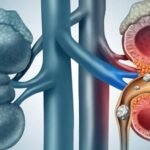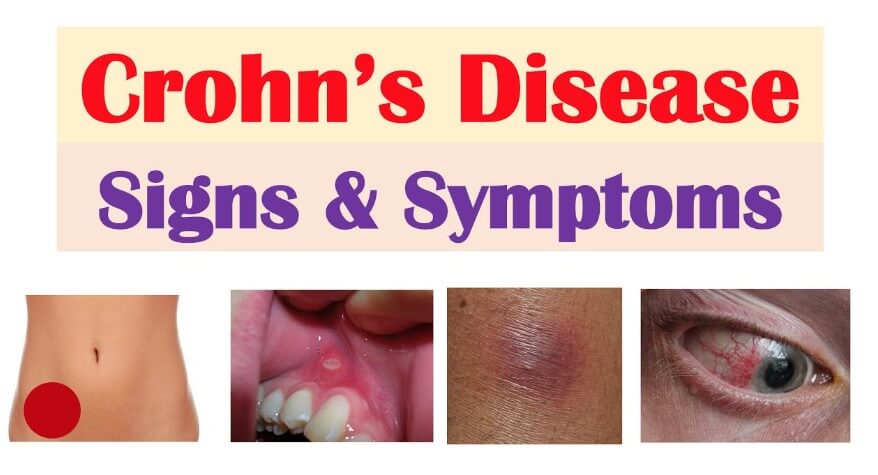Crohn’s disease is a long illness that makes the digestive system swollen. It can affect any part from the mouth to the bottom but usually happens in the small and large intestines. Crohn’s Disease Symptoms can vary widely because of this. Doctors don’t know the exact cause, but it may be from a mix of genes, the environment, and the immune system.
One of the most challenging aspects of Crohn’s disease is its unpredictable nature. Symptoms can be mild or strong and may start slowly or suddenly. Crohn’s is a long illness that sometimes gets worse and sometimes gets better. Knowing the early signs helps you get help and manage the disease better. Know more about Crohn’s disease on our website.

Common Digestive Crohn’s Disease Symptoms
The most common signs of Crohn’s disease usually affect the digestive system. Swelling can happen anywhere in the gut, so symptoms can be different based on where and how bad it is.
One of the hallmark Crohn’s Disease Symptoms is persistent diarrhea. This isn’t your typical case of an upset stomach. The diarrhea associated with Crohn’s is often chronic and can happen several times a day. It may also come with an urgent need to use the bathroom, which can disrupt daily life.
Another common symptom is abdominal pain and cramping. The pain is often in the lower right belly but can happen anywhere the intestine is affected. The cramps come from swelling and sores in the bowel that make it hard for food to move through.
People with Crohn’s Disease Symptoms often feel bloated and full. This can make them lose their appetite and lose weight without trying. Swelling and needing to go to the bathroom a lot can keep your body from getting enough food to stay healthy.
Blood in Stool and Rectal Bleeding
A particularly alarming symptom of Crohn’s disease is the presence of blood in the stool. Blood in poop can be bright red from near the bottom, or dark and sticky if it’s from higher inside. Sometimes, you might also notice mucus or feel like you haven’t fully emptied your bowels.
Blood in your stool can happen for many reasons, but if it happens a lot, don’t ignore it. It means there’s a problem in your intestines that needs a doctor’s check.
Fatigue and General Malaise
Fatigue is one of the most common yet overlooked symptoms of Crohn’s disease. Swelling, not enough good food, and bad sleep from belly pain can make people very tired. Unlike normal tiredness, this type of fatigue does not improve significantly with rest.
Some of the common Crohn’s Disease Symptoms include feeling constantly worn out or weak. Feeling tired and unwell is hard to explain, but it’s a real part of Crohn’s disease. It can impact a person’s ability to work, socialize, and maintain a normal routine.
Fever and Night Sweats
Low-grade fever is another sign of active inflammation in the body. When Crohn’s flares up, the body’s defense system works too hard, causing a fever. Sometimes, people also get chills or sweat at night, making it hard to sleep and causing tiredness.
These Crohn’s Disease Symptoms happen more when Crohn’s is active or serious. A fever now and then may seem small, but if it happens often with other stomach problems, you should see a doctor.
Joint Pain and Inflammation
Crohn’s disease isn’t limited to the digestive system. Crohn’s disease can affect parts of the body outside the gut, like the joints. Some people’s knees, ankles, or elbows hurt, swell, and feel stiff, especially when Crohn’s is active.
In some cases, Crohn’s Disease Symptoms like joint issues may come before stomach problems, making diagnosis harder. If a person has joint pain and stomach problems, a doctor might check for Crohn’s disease.
Mouth Sores and Ulcers
Painful sores in the mouth are a common sign, especially when Crohn’s gets worse. These lesions, often similar to canker sores, can make eating and speaking uncomfortable. They happen because of swelling in the mouth lining and can mean the disease is active in the gut.
Mouth sores can happen for many reasons. If someone with Crohn’s gets them often or for a long time, it might be because of the disease.
Skin Issues and Rashes
Crohn’s disease can also show up on the skin. People with Crohn’s might get red, sore bumps on their legs called erythema nodosum. Sometimes, people get painful skin sores when Crohn’s is worse.
These skin problems are caused by inflammation and are more than just skin deep. These often happen when Crohn’s gets worse and show that the body is swollen inside.
Eye Problems
Crohn’s disease can sometimes cause swelling in parts of the eye, like the colored part (iris) or the white part. Symptoms may include redness, pain, blurred vision, and sensitivity to light. Left untreated, eye inflammation can lead to complications, so prompt treatment is important.
If a person with Crohn’s has sudden eye pain or trouble seeing, they should see a doctor right away.
Delayed Growth in Children
For children and adolescents, Crohn’s disease can interfere with growth and development. Swelling for a long time and not getting enough good food can make kids grow slower and stay shorter. In many cases, slowed growth is one of the first noticeable signs of Crohn’s in young people.
Kids with Crohn’s might not always have common symptoms like diarrhea or pain, so it can be hard to spot early. Knowing this can help doctors test and treat it sooner, which helps kids feel better in the long run.

Mental Health Effects
Living with Crohn’s disease can take a significant emotional toll. Crohn’s symptoms come and go. The pain, diet changes, and feeling alone can make people feel sad or worried. The psychological burden of managing a chronic illness is real and valid.
People with Crohn’s Disease Symptoms sometimes feel shy when they need to go to the bathroom quickly outside or at work. Talking to a therapist or joining a support group can really help.
When to See a Doctor
Crohn’s disease can look like other problems, like IBS, celiac disease, or food issues. If you have ongoing stomach problems, weight loss, or feel very tired, it’s a good idea to see a doctor.
Early diagnosis is key. Crohn’s disease can’t be cured, but treatments can help you feel better and have fewer symptoms. These include medications, lifestyle changes, dietary adjustments, and sometimes surgery.
To see if you have Crohn’s, doctors may test your blood and poop and use special tools to look inside your belly.
Final Thoughts: Recognizing the Symptoms of Crohn’s Disease
Crohn’s disease is a tricky condition that doesn’t just affect your stomach. It can also make you tired, change your mood, and cause problems with your skin and joints. Knowing the signs early can help you take steps to feel better and keep it under control.
No matter if your Crohn’s Disease Symptoms are mild or strong, it’s important to remember that help is available. Crohn’s is easier to handle with help from doctors, food experts, counselors, and family or friends.
If you or someone you love is dealing with ongoing digestive discomfort, don’t dismiss the signs. Awareness is the first step toward relief and improved quality of life. The sooner you get help, the easier it is to find treatment that works and feel better for longer.
Read more about: Kidney Stones: Causes, Symptoms, Treatment & Prevention – Everything You Need to Know














